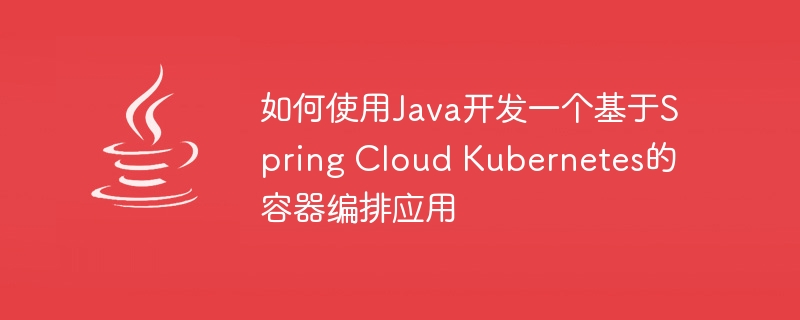Home >Java >javaTutorial >How to use Java to develop a container orchestration application based on Spring Cloud Kubernetes
How to use Java to develop a container orchestration application based on Spring Cloud Kubernetes
- WBOYWBOYWBOYWBOYWBOYWBOYWBOYWBOYWBOYWBOYWBOYWBOYWBOriginal
- 2023-09-20 11:15:191105browse

How to use Java to develop a container orchestration application based on Spring Cloud Kubernetes
With the development and widespread application of container technology, container orchestration tools have also become indispensable for developers. A missing part. As one of the most popular container orchestration tools, Kubernetes has become the industry standard. In this context, combining Spring Cloud and Kubernetes, we can easily develop applications based on container orchestration.
This article will introduce in detail how to use Java to develop a container orchestration application based on Spring Cloud Kubernetes, and provide corresponding code examples for reference.
1. Build a development environment
In order to write an application based on Spring Cloud Kubernetes, you first need to prepare the following development environment:
- Install the Java development environment (JDK)
- Install Apache Maven, and configure it accordingly
- Install Docker and Kubernetes, and configure it accordingly
2. Create a Spring Cloud Kubernetes project
- Open an IDE (such as IntelliJ IDEA) and create a new Maven project.
- Add the following dependencies in the pom.xml file:
<dependencies>
<!-- Spring Boot 依赖 -->
<dependency>
<groupId>org.springframework.boot</groupId>
<artifactId>spring-boot-starter-web</artifactId>
</dependency>
<!-- Spring Cloud Kubernetes 依赖 -->
<dependency>
<groupId>org.springframework.cloud</groupId>
<artifactId>spring-cloud-starter-kubernetes-all</artifactId>
<version>2.2.0.RELEASE</version>
</dependency>
</dependencies>- Create a simple Controller class and add a sample interface. The code example is as follows:
import org.springframework.web.bind.annotation.GetMapping;
import org.springframework.web.bind.annotation.RequestMapping;
import org.springframework.web.bind.annotation.RestController;
@RestController
@RequestMapping("/hello")
public class HelloWorldController {
@GetMapping
public String hello() {
return "Hello, Kubernetes!";
}
}- In the main application class, add the
@EnableDiscoveryClientand@SpringBootApplicationannotations. The code example is as follows:
import org.springframework.boot.SpringApplication;
import org.springframework.boot.autoconfigure.SpringBootApplication;
import org.springframework.cloud.client.discovery.EnableDiscoveryClient;
@SpringBootApplication
@EnableDiscoveryClient
public class Application {
public static void main(String[] args) {
SpringApplication.run(Application.class, args);
}
}3. Deploy the application to the Kubernetes cluster
- Open the command line window and enter the root directory of the application project.
- Execute the following command to generate the Docker image:
mvn spring-boot:build-image
- Next, push the Docker image to the mirror warehouse. Taking Docker Hub as an example, execute the following command:
docker push [镜像名称]
- Create a Kubernetes deployment configuration file (deployment.yaml) to describe the deployment information of the application. An example is as follows:
apiVersion: apps/v1
kind: Deployment
metadata:
name: demo-app
spec:
replicas: 3
selector:
matchLabels:
app: demo-app
template:
metadata:
labels:
app: demo-app
spec:
containers:
- name: demo-app
image: [镜像名称]
ports:
- containerPort: 8080- Use the following command to deploy the application to the Kubernetes cluster:
kubectl apply -f deployment.yaml
4. Verify the application deployment
- Execute the following command to check the application’s Pod running status:
kubectl get pods
- If everything is normal, you can use the following command to expose the application’s services:
kubectl expose deployment demo-app --type=LoadBalancer --name=demo-service
- Execute the following command to view the IP address of the application service:
kubectl get services
- Use a browser or other tools to access the IP address of the application service, plus the path of the sample interface (such as
/hello), if "Hello, Kubernetes!" can be returned normally, the application deployment is successful.
Through the above steps, we successfully developed and deployed a container orchestration application based on Spring Cloud Kubernetes using Java. In actual development, we can further expand and improve application functions according to specific needs. At the same time, it can also be combined with other features provided by Spring Cloud Kubernetes, such as configuration management, service discovery, etc., to further optimize the application's container orchestration capabilities.
I hope this article will help you understand how to use Java to develop container orchestration applications based on Spring Cloud Kubernetes. If you have questions or need detailed code examples, you can refer to the official Spring Cloud Kubernetes documentation or communicate and discuss with the community. I wish you every success in container orchestration application development!
The above is the detailed content of How to use Java to develop a container orchestration application based on Spring Cloud Kubernetes. For more information, please follow other related articles on the PHP Chinese website!
Related articles
See more- Java Backend Development: API Deployment with Kubernetes
- Monitoring and alarm practice under Spring Cloud microservice architecture
- Data governance practice based on Spring Cloud
- How to deal with inter-thread communication issues in Java development
- How to configure a container management platform (such as Kubernetes) on Linux

